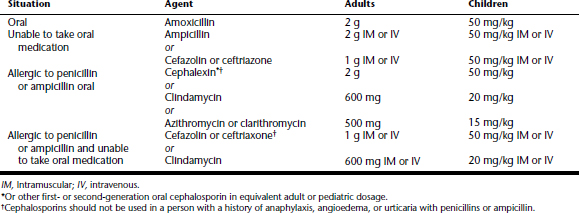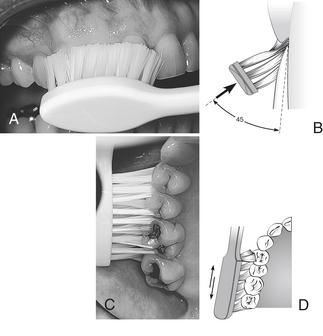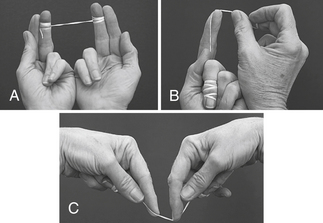SECTION I General Dentistry
PROPHYLACTIC ANTIBIOTICS FOR PREMEDICATION
Patient Name: ________________________ Date: ______________
Reasons for antibiotic premedication are:
 Prosthetic heart valve or prosthetic material used for cardiac valve repair including bioprosthetic and homograft valves
Prosthetic heart valve or prosthetic material used for cardiac valve repair including bioprosthetic and homograft valvesSTAYING WELL: HOW TO KEEP YOUR MOUTH HEALTHY
Patient Name: ________________________ Date: ______________
 Brushing and flossing cleans only about 20% of the mouth. To reach the other 80%, we recommend that you rinse twice daily for 30 seconds with an ADA-accepted antimicrobial mouth rinse. If you experience dry mouth symptoms, we recommend that you: _______________________
Brushing and flossing cleans only about 20% of the mouth. To reach the other 80%, we recommend that you rinse twice daily for 30 seconds with an ADA-accepted antimicrobial mouth rinse. If you experience dry mouth symptoms, we recommend that you: _______________________ Given your unique oral care needs, we also recommend the following oral care products and/or devices for your use:_______________________
Given your unique oral care needs, we also recommend the following oral care products and/or devices for your use:_______________________ Come to the office for recare hygiene appointments at the specific intervals we recommend. This is very important. Every mouth is different. Based on the number of dental restorations you have, the number and alignment of your teeth, your apparent ability at this time to keep your teeth clean, and your medical history, we recommend that the interval be no longer than ____ months. With this interval, there is the best opportunity to prevent gum disease or correct problems found early when they are small, easier, and less expensive to treat.
Come to the office for recare hygiene appointments at the specific intervals we recommend. This is very important. Every mouth is different. Based on the number of dental restorations you have, the number and alignment of your teeth, your apparent ability at this time to keep your teeth clean, and your medical history, we recommend that the interval be no longer than ____ months. With this interval, there is the best opportunity to prevent gum disease or correct problems found early when they are small, easier, and less expensive to treat. Each time you come in for procedural dental hygiene care, make your next hygiene recare appointment before you leave the office. But please try to remember when you are due for an appointment. No matter how attractive we make our reminder cards, they seem to have a habit of getting mixed up in junk mail and being discarded without being noticed.
Each time you come in for procedural dental hygiene care, make your next hygiene recare appointment before you leave the office. But please try to remember when you are due for an appointment. No matter how attractive we make our reminder cards, they seem to have a habit of getting mixed up in junk mail and being discarded without being noticed. If you have followed our advice, you should receive years of successful service from your teeth. Natural teeth and restorative materials are subjected to great stress on a daily basis. Please do not put things in your mouth that do not belong there. This will tremendously shorten the effective life span of your teeth and restorations.
If you have followed our advice, you should receive years of successful service from your teeth. Natural teeth and restorative materials are subjected to great stress on a daily basis. Please do not put things in your mouth that do not belong there. This will tremendously shorten the effective life span of your teeth and restorations. Do not chew on ice or frozen candy bars, bite on hard candy, or keep hard candy or breath mints in your mouth on a routine basis. Any sugary food that you keep in your mouth for a long time (as it dissolves) can easily and quickly cause tooth decay. You can use sugar-free candy and mints that contain xylitol.
Do not chew on ice or frozen candy bars, bite on hard candy, or keep hard candy or breath mints in your mouth on a routine basis. Any sugary food that you keep in your mouth for a long time (as it dissolves) can easily and quickly cause tooth decay. You can use sugar-free candy and mints that contain xylitol. If you smoke, stop. Remember that smoking has a negative effect on your gum tissue and on your general health.
If you smoke, stop. Remember that smoking has a negative effect on your gum tissue and on your general health. Smoking and drinking coffee, tea, and cola beverages will have a tendency to stain or darken your teeth over time. This can be reversed with your regular recare dental hygiene and, if necessary, noninvasive tooth whitening procedures.
Smoking and drinking coffee, tea, and cola beverages will have a tendency to stain or darken your teeth over time. This can be reversed with your regular recare dental hygiene and, if necessary, noninvasive tooth whitening procedures. If you are having your dental treatment scheduled for time or financial reasons, please continue at the time we have discussed.
If you are having your dental treatment scheduled for time or financial reasons, please continue at the time we have discussed. If you have had a protective mouth guard made (to protect your teeth and new restorations or reduce the effects of a bruxing or grinding habit), please wear it as instructed.
If you have had a protective mouth guard made (to protect your teeth and new restorations or reduce the effects of a bruxing or grinding habit), please wear it as instructed.Thank you for giving us the opportunity to serve you, and we hope to see you soon.
HOW TO BRUSH! HOW TO FLOSS!
Patient Name: ________________________ Date: ______________
THE MODIFIED BASS METHOD
 The bristles of the brush should be angled toward the area where the tooth meets the gum, approximately a 45-degree angle.
The bristles of the brush should be angled toward the area where the tooth meets the gum, approximately a 45-degree angle. The bristles of the brush should be able to gently slide under the gum tissue. Gently move the brush back and forth so that there is a vibrating motion, not a scrubbing motion. The brush head should be able to cover and clean about two teeth at a time.
The bristles of the brush should be able to gently slide under the gum tissue. Gently move the brush back and forth so that there is a vibrating motion, not a scrubbing motion. The brush head should be able to cover and clean about two teeth at a time. Brush each area for about 10 seconds, then roll the bristles to the biting surface. Move the brush head so that it overlaps a small portion of the tooth just brushed and the next teeth. Repeat until all teeth have been brushed.
Brush each area for about 10 seconds, then roll the bristles to the biting surface. Move the brush head so that it overlaps a small portion of the tooth just brushed and the next teeth. Repeat until all teeth have been brushed.USE OF DENTAL FLOSS
 Lightly wrap the floss around the forefingers of each hand until there is a length of about 1 to 11⁄2 inches available between the fingers. Don’t wrap it so tightly that you cut off circulation and your fingers turn blue!
Lightly wrap the floss around the forefingers of each hand until there is a length of about 1 to 11⁄2 inches available between the fingers. Don’t wrap it so tightly that you cut off circulation and your fingers turn blue! With a gentle buffing motion, back and forth, move the floss between the teeth and slide it first under the gum around one of the teeth in a U shape.
With a gentle buffing motion, back and forth, move the floss between the teeth and slide it first under the gum around one of the teeth in a U shape. Move the floss up and down a few times, then reverse the U and floss the other tooth. The floss needs to get under the gum.
Move the floss up and down a few times, then reverse the U and floss the other tooth. The floss needs to get under the gum. Then remove the floss and place it between the next two teeth. Holding the floss taut between your fingers will give you more control, and flossing will be easier. If you see blood on the floss, try to clean the gum area more thoroughly for several days until the bleeding stops. If you continue to see bleeding, contact your dental hygienist.
Then remove the floss and place it between the next two teeth. Holding the floss taut between your fingers will give you more control, and flossing will be easier. If you see blood on the floss, try to clean the gum area more thoroughly for several days until the bleeding stops. If you continue to see bleeding, contact your dental hygienist. Note that some people benefit from other types of interdental cleaning aids such as interdental brushes and sponges, wooden piks, and end-tufted brushes. Ask your dental hygienist if these oral care devices are appropriate for you.
Note that some people benefit from other types of interdental cleaning aids such as interdental brushes and sponges, wooden piks, and end-tufted brushes. Ask your dental hygienist if these oral care devices are appropriate for you. Remember, brushing and flossing cleans only about 20% of the mouth. To reach the other 80%, we recommend that you rinse twice daily for 30 seconds with an ADA-accepted antimicrobial mouth rinse.
Remember, brushing and flossing cleans only about 20% of the mouth. To reach the other 80%, we recommend that you rinse twice daily for 30 seconds with an ADA-accepted antimicrobial mouth rinse.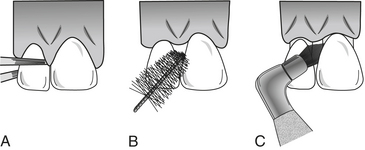
Use of interdental plaque control devices. A, Dental floss. B, Interdental brush. C, End-tuft brush.
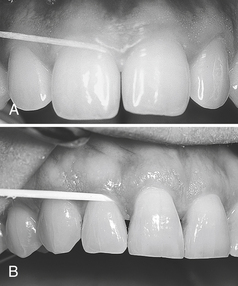
A, Dental floss. B, Dental tape.
(A, from Perry DA, Beemsterboer PL: Periodontology for the dental hygienist, St Louis, 2007, Saunders. B, from Newman MG, Takei HH, Klokkevold PR, Carranza FA: Carranza’s clinical periodontology, ed 10, St Louis, 2006, Saunders.)
If you have any questions about how to brush or floss, please feel free to ask us.
Stay updated, free dental videos. Join our Telegram channel

VIDEdental - Online dental courses














